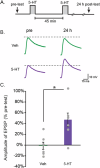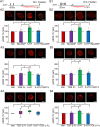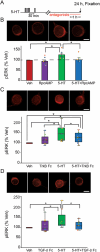Dynamics and Mechanisms of ERK Activation after Different Protocols that Induce Long-Term Synaptic Facilitation in Aplysia
- PMID: 37649778
- PMCID: PMC10464504
- DOI: 10.1093/oons/kvac014
Dynamics and Mechanisms of ERK Activation after Different Protocols that Induce Long-Term Synaptic Facilitation in Aplysia
Abstract
Phosphorylation of the MAPK family member extracellular signal-regulated kinase (ERK) is required to induce long-term synaptic plasticity, but little is known about its persistence. We examined ERK activation by three protocols that induce long-term synaptic facilitation (LTF) of the Aplysia sensorimotor synapse - the standard protocol (five 5-min pulses of 5-HT with interstimulus intervals (ISIs) of 20 min), the enhanced protocol (five pulses with irregular ISIs, which induces greater and longer-lasting LTF) and the two-pulse protocol (two pulses with ISI 45 min). Immunofluorescence revealed complex ERK activation. The standard and two-pulse protocols immediately increased active, phosphorylated ERK (pERK), which decayed within 5 h. A second wave of increased pERK was detected 18 h post-treatment for all protocols. This late phase was blocked by inhibitors of protein kinase A, TrkB and TGF-β. These results suggest that complex interactions among kinase pathways and growth factors contribute to the late increase of pERK. ERK activity returned to basal 24 h after the standard or two-pulse protocols, but remained elevated 24 h for the enhanced protocol. This 24-h elevation was also dependent on PKA and TGF-β, and partly on TrkB. These results begin to characterize long-lasting ERK activation, plausibly maintained by positive feedback involving growth factors and PKA, that appears essential to maintain LTF and LTM. Because many processes involved in LTF and late LTP are conserved among Aplysia and mammals, these findings highlight the importance of examining the dynamics of kinase cascades involved in vertebrate long-term memory.
Keywords: Aplysia; ERK; TGF-β; TrkB; computationally designed training protocol; long-term facilitation.
© The Author(s) 2022. Published by Oxford University Press.
Conflict of interest statement
None declared.
Figures





References
-
- Abel T, Nguyen PV, Barad Met al. . Genetic demonstration of a role for PKA in the late phase of LTP and in hippocampus-based long-term memory. Cell. 1997;88:615–26 PMID: 9054501 - PubMed
-
- Adams JP, Sweatt JD. Molecular psychology: roles for the ERK MAP kinase cascade in memory. Annu Rev Pharmacol Toxicol. 2002;42:135–63 PMID: 11807168 - PubMed
Grants and funding
LinkOut - more resources
Full Text Sources
Miscellaneous
